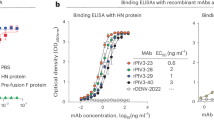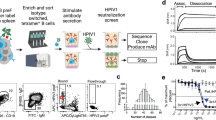Abstract
Broadly neutralizing antibodies reactive against most and even all variants of the same viral species have been described for influenza and HIV-1 (ref. 1). However, whether a neutralizing antibody could have the breadth of range to target different viral species was unknown. Human respiratory syncytial virus (HRSV) and human metapneumovirus (HMPV) are common pathogens that cause severe disease in premature newborns, hospitalized children2,3 and immune-compromised patients2,4,5, and play a role in asthma exacerbations6. Although antisera generated against either HRSV or HMPV are not cross-neutralizing7, we speculated that, because of the repeated exposure to these viruses, cross-neutralizing antibodies may be selected in some individuals. Here we describe a human monoclonal antibody (MPE8) that potently cross-neutralizes HRSV and HMPV as well as two animal paramyxoviruses: bovine RSV (BRSV) and pneumonia virus of mice (PVM). In its germline configuration, MPE8 is HRSV-specific and its breadth is achieved by somatic mutations in the light chain variable region. MPE8 did not result in the selection of viral escape mutants that evaded antibody targeting and showed potent prophylactic efficacy in animal models of HRSV and HMPV infection, as well as prophylactic and therapeutic efficacy in the more relevant model of lethal PVM infection. The core epitope of MPE8 was mapped on two highly conserved anti-parallel β-strands on the pre-fusion viral F protein, which are rearranged in the post-fusion F protein conformation. Twenty-six out of the thirty HRSV-specific neutralizing antibodies isolated were also found to be specific for the pre-fusion F protein. Taken together, these results indicate that MPE8 might be used for the prophylaxis and therapy of severe HRSV and HMPV infections and identify the pre-fusion F protein as a candidate HRSV vaccine.
This is a preview of subscription content, access via your institution
Access options
Subscribe to this journal
Receive 51 print issues and online access
$199.00 per year
only $3.90 per issue
Buy this article
- Purchase on SpringerLink
- Instant access to full article PDF
Prices may be subject to local taxes which are calculated during checkout




Similar content being viewed by others
References
Corti, D. & Lanzavecchia, A. Broadly neutralizing antiviral antibodies. Annu. Rev. Immunol. 31, 705–742 (2013)
Hall, C. B. et al. The burden of respiratory syncytial virus infection in young children. N. Engl. J. Med. 360, 588–598 (2009)
Edwards, K. M. et al. Burden of human metapneumovirus infection in young children. N. Engl. J. Med. 368, 633–643 (2013)
Williams, J. V. et al. Human metapneumovirus and lower respiratory tract disease in otherwise healthy infants and children. N. Engl. J. Med. 350, 443–450 (2004)
Falsey, A. R., Hennessey, P. A., Formica, M. A., Cox, C. & Walsh, E. E. Respiratory syncytial virus infection in elderly and high-risk adults. N. Engl. J. Med. 352, 1749–1759 (2005)
Edwards, M. R., Bartlett, N. W., Hussell, T., Openshaw, P. & Johnston, S. L. The microbiology of asthma. Nature Rev. Immunol. 10, 459–471 (2012)
Wyde, P. R., Chetty, S. N., Jewell, A. M., Boivin, G. & Piedra, P. A. Comparison of the inhibition of human metapneumovirus and respiratory syncytial virus by ribavirin and immune serum globulin in vitro. Antiviral Res. 60, 51–59 (2003)
Collins, P. L. & Crowe, J. E., Jr in Fields Virology 6th edn. (eds Knipe D. M. & Howley P. M. ) Respiratory syncytial virus and metapneumovirus (Lippincott Williams & Wilkins, 2013)
van den Hoogen, B. G. et al. A newly discovered human pneumovirus isolated from young children with respiratory tract disease. Nature Med. 7, 719–724 (2001)
Groothuis, J. R., Simoes, E. A., Hemming, V. G. & Respiratory Syncytial Virus Immune Globulin Study Group Respiratory syncytial virus (RSV) infection in preterm infants and the protective effects of RSV immune globulin (RSVIG). Pediatrics 95, 463–467 (1995)
The-IMpact–RSV Study Group Palivizumab, a humanized respiratory syncytial virus monoclonal antibody, reduces hospitalization from respiratory syncytial virus infection in high-risk infants. Pediatrics 102, 531–537 (1998)
de Fontbrune, F. S. et al. Palivizumab treatment of respiratory syncytial virus infection after allogeneic hematopoietic stem cell transplantation. Clin. Infect. Dis. 45, 1019–1024 (2007)
Adams, O. et al. Palivizumab-resistant human respiratory syncytial virus infection in infancy. Clin. Infect. Dis. 51, 185–188 (2010)
Traggiai, E. et al. An efficient method to make human monoclonal antibodies from memory B cells: potent neutralization of SARS coronavirus. Nature Med. 10, 871–875 (2004)
Kwakkenbos, M. J. et al. Generation of stable monoclonal antibody-producing B cell receptor-positive human memory B cells by genetic programming. Nature Med. 16, 123–128 (2010)
Ulbrandt, N. D. et al. Isolation and characterization of monoclonal antibodies which neutralize human metapneumovirus in vitro and in vivo. J. Virol. 80, 7799–7806 (2006)
Beeler, J. A. & van Wyke Coelingh, K. Neutralization epitopes of the F glycoprotein of respiratory syncytial virus: effect of mutation upon fusion function. J. Virol. 63, 2941–2950 (1989)
Magro, M. et al. Neutralizing antibodies against the preactive form of respiratory syncytial virus fusion protein offer unique possibilities for clinical intervention. Proc. Natl Acad. Sci. USA 109, 3089–3094 (2012)
Swanson, K. A. et al. Structural basis for immunization with postfusion respiratory syncytial virus fusion F glycoprotein (RSV F) to elicit high neutralizing antibody titers. Proc. Natl Acad. Sci. USA 108, 9619–9624 (2011)
Calder, L. J. Electron microscopy of the human respiratory syncytial virus fusion protein and complexes that it forms with monoclonal antibodies. Virology 271, 122–131 (2000)
Connolly, S. A., Leser, G. P., Yin, H.-S., Jardetzky, T. S. & Lamb, R. A. Refolding of a paramyxovirus F protein from prefusion to postfusion conformations observed by liposome binding and electron microscopy. Proc. Natl Acad. Sci. USA 103, 17903–17908 (2006)
McLellan, J. S. et al. Structure of a major antigenic site on the respiratory syncytial virus fusion glycoprotein in complex with neutralizing antibody 101F. J. Virol. 84, 12236–12244 (2010)
McLellan, J. S. et al. Structure of RSV fusion glycoprotein trimer bound to a prefusion-specific neutralizing antibody. Science 340, 1113–1117 (2013)
Zhu, Q. et al. Natural polymorphisms and resistance-associated mutations in the fusion protein of respiratory syncytial virus (RSV): effects on RSV susceptibility to palivizumab. J. Infect. Dis. 205, 635–638 (2012)
Zhao, X. Respiratory syncytial virus escape mutant derived in vitro resists palivizumab prophylaxis in cotton rats. Virology 318, 608–612 (2004)
Durbin, J. E. et al. The role of IFN in respiratory syncytial virus pathogenesis. J. Immunol. 168, 2944–2952 (2002)
Domachowske, J. B., Bonville, C. A. & Rosenberg, H. F. Animal models for studying respiratory syncytial virus infection and its long term effects on lung function. Pediatr. Infect. Dis. J. 23, S228–S234 (2004)
Shah, J. N. & Chemaly, R. F. Management of RSV infections in adult recipients of hematopoietic stem cell transplantation. Blood 117, 2755–2763 (2011)
Bonville, C. A. et al. Functional antagonism of chemokine receptor CCR1 reduces mortality in acute pneumovirus infection in vivo. J. Virol. 78, 7984–7989 (2004)
Greensill, J. et al. Human metapneumovirus in severe respiratory syncytial virus bronchiolitis. Emerg. Infect. Dis. 9, 372–375 (2003)
Tiller, T. et al. Efficient generation of monoclonal antibodies from single human B cells by single cell RT-PCR and expression vector cloning. J. Immunol. Methods 329, 112–124 (2008)
Lefranc, M.-P. et al. IMGT, the international ImMunoGeneTics information system. Nucleic Acids Res. 37, D1006–D1012 (2009)
Tamura, K. et al. MEGA5: molecular evolutionary genetics analysis using maximum likelihood, evolutionary distance, and maximum parsimony methods. Mol. Biol. Evol. 28, 2731–2739 (2011)
Timmerman, P., Puijk, W. C. & Meloen, R. H. Functional reconstruction and synthetic mimicry of a conformational epitope using CLIPS technology. J. Mol. Recognit. 20, 283–299 (2007)
Slootstra, J. W., Puijk, W. C., Ligtvoet, G. J., Langeveld, J. P. & Meloen, R. H. Structural aspects of antibody-antigen interaction revealed through small random peptide libraries. Mol. Divers. 1, 87–96 (1996)
Acknowledgements
We would like to thank M. Nussenzweig and H. Wardemann for providing reagents for antibody cloning and expression, I. Capua, B. Zecchin and L. Selli for experiments involving BRSV and R. Wepf for electron microscopy. This work was supported by the European Research Council (grant no. 250348 IMMUNExplore) and the Swiss National Science Foundation (grant no. 141254). A.L. is supported by the Helmut Horten Foundation.
Author information
Authors and Affiliations
Contributions
D.C. designed experiments, analysed the data and wrote the manuscript; S.B., F.V., C.S., B.G. performed and analysed in vitro experiments; A.M., G.A., B.J.M. performed and analysed in vivo experiments; L.P. and J.M. prepared pre- and post-fusion F proteins and performed SPR experiments; F.B., E.P. and A.P. isolated and sequenced HRSV and HMPV strains; F.S. wrote the manuscript; A.L. provided overall supervision, analysed the data and wrote the manuscript.
Corresponding authors
Ethics declarations
Competing interests
A.L. is the scientific founder of Humabs BioMed SA. A.L. and F.S. hold shares in Humabs BioMed SA.
Supplementary information
Supplementary Information
This file contains Supplementary Figures 1-14 and Supplementary Tables 1-2. (PDF 9901 kb)
Rights and permissions
About this article
Cite this article
Corti, D., Bianchi, S., Vanzetta, F. et al. Cross-neutralization of four paramyxoviruses by a human monoclonal antibody. Nature 501, 439–443 (2013). https://doi.org/10.1038/nature12442
Received:
Accepted:
Published:
Issue Date:
DOI: https://doi.org/10.1038/nature12442
This article is cited by
-
Cross-protective antibodies against common endemic respiratory viruses
Nature Communications (2023)
-
Structure and antigenicity of divergent Henipavirus fusion glycoproteins
Nature Communications (2023)
-
A decade of human metapneumovirus in hospitalized children with acute respiratory infection: molecular epidemiology in central Vietnam, 2007–2017
Scientific Reports (2023)
-
Structure-based design of prefusion-stabilized human metapneumovirus fusion proteins
Nature Communications (2022)
-
Profiling of hMPV F-specific antibodies isolated from human memory B cells
Nature Communications (2022)



